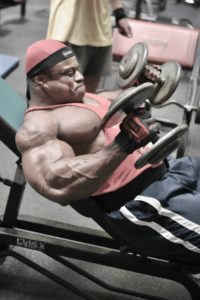
Essential guidelines in building bigger and stronger biceps and triceps
By Strength Sensei CP
Publication Date: 1997
As I’m sure some pharmacist once said, “Sometimes the best medicine is not laughter, but medicine!” As such, if you’ve sustained a serious arm injury, find a therapist who can determine what’s wrong with you and prescribe the appropriate treatment.
With that public service announcement out of the way, let’s move on to discussing how to ease back into training and avoiding getting injured again. The following are five training guidelines that will not only help you stay injury-free, but can help you achieve the fastest results from your arm training workouts:
- Perform an adequate warm-up.One reason heavy duty bodybuilders get heavy duty injuries is that they don’t warm up. A practical guideline for direct arm training is to perform 3-5 warm-up sets and do low reps – yes, low reps.
You don’t want to perform high reps in your warm-up, even if your primary training sets require high reps. High reps elevate your lactic-acid levels, which elevate your blood pH, and a high blood pH prevents your nervous system from recruiting high-threshold motor units.
- Focus on dumbbell exercises.Dumbbells are less restrictive on the elbow and shoulder joints than barbells. Forcing the joints into an unnatural movement pattern, which occurs with many barbell exercises, places stress on the joints that may cause injury. This is especially true with the standing barbell curl, which many bodybuilders can’t perform because of the unnatural stress it puts on the wrists and elbows.
 Dumbbell exercises are easier on the elbows and shoulders than many barbell exercises. (All photos by Miloš Šarčev)
Dumbbell exercises are easier on the elbows and shoulders than many barbell exercises. (All photos by Miloš Šarčev)
- Maintain proper neck alignment.Posture is essential for the prevention of many injuries, particularly those to the neck. A common mistake many trainers make is to twist the head from side-to-side while straining for the last rep – that’s asking for a trip to the chiropractor. Also, you should never protract the neck (the vulture posture), a fault that often occurs when performing standing and seated arm exercise. Instead, concentrate on keeping your chin down and your chest high, lifting your sternum, when curling.
 Always ensure proper neck alignment when performing arm exercises.
Always ensure proper neck alignment when performing arm exercises.
- Maintain proper wrist alignment.The effects of improper wrist alignment can be seen anytime you visit a grocery store – carpel tunnel has become an epidemic among cashiers (and a gold mine for therapists). To avoid chronic injury, keep your wrists in a neutral position when performing triceps work—and use wrist wraps.
 Well-developed biceps, triceps, and forearms are noticeable from all angles.
Well-developed biceps, triceps, and forearms are noticeable from all angles.
- Practice the principle of technical limit.The path of the bar should remain identical from rep one till the end of the set. When you deviate from the path to continue an exercise, you have exceeded the “technical limit” of the exercise and are probably placing the joints in a more stressful lifting posture. Another benefit of adhering to the technical limit principle is that such consistency with proper technique improves concentration.
I’m all for training hard, but you also have to train smart to ensure injuries don’t interrupt your progress. Follow these five guidelines for arm training and give your guns an edge in the arms race!
